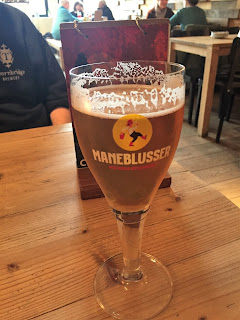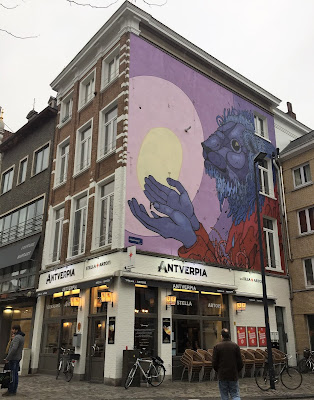Mechelen (Malines) lies between Brussels and Antwerp and is on the river Dijle which also flows through Leuven. The city looks unimpressive from the elevated railway line but as the home of Het Anker brewery it deserves a visit. A day trip to Mechelen would take up most of our second day in Belgium.
The lively Saturday market at Boulevard de l'Europe was a distraction as we walked to Brussels Midi station. However, dates on branches, figs, colourful fabrics, trailers of well displayed bakery goods and charcuterie did not tempt us to make any purchases.
We paid 5.80 euros each for a weekend return ticket and travelled on the 11.00 Antwerp train arriving in Mechelen at 11.26.
On the train, Simon planned some bars to visit based on a list from Sue and John Thirlaway who know many of them. It was a disappointment to find
Cafe de Olifant, near the station was closed and we resolved to return there later before catching the train back to Brussels.
We walked towards the Grote Markt in the city centre. After crossing the ring road there was little vehicle traffic.
We also crossed the river Dijle and followed the Bruul shopping street until we reached the Grote Markt which was busy with shoppers and market stalls.
 |
| 'T Ankercafe |
As
'T Ankercafe on the south side of the square looked busy we crossed to the north side.
SAVA
 |
| SAVA |
We went inside
SAVA and as the ground floor was full we found a free table upstairs.
This was a high ceilinged space with pale wood tables and light from tall windows overlooking the square. SAVA is a cafe with Tapas but we only ordered beers here. My blond
Het Anker Maneblusser (5.8% ABV) was named after the Belgian nickname for people from Mechelen which means 'extinguishers of the moon'.
We would later learn from Marc de Knijf on the Het Anker brewery tour that this nickname is based on the 1687 tale of a false fire alarm when people from Mechelen climbed the tower of St Rumbold's cathedral carrying buckets of water only to find that the mist, assumed to be smoke, had cleared revealing only the fiery red glow of the full moon.
During the 1km walk to Het Anker brewery we passed St Rumbold's cathedral and beyond it found the climbable figure of Opsinjoor. Later
research shows that Mechelen folklore and tradition involves bouncing a wooden doll, representing a drunken wifebeater, into the air from a linen sheet and his name is derived from the Spanish word Señor.
See
Het Anker brewery Mechelen post for details of our tour and tasting at the brewery situated in the historic
beguinage district just inside the city's ring road.
After the tour, weighted down with some bottles of Het Anker beer purchased in the shop, we set off towards Ankertje aan de Dijle via the cobbled streets of the beguinage with its attractive traditional buildings.
 |
| Kraanbrug over river Dijle |
Arriving at the river we crossed to the south bank and headed towards the old Lamot brewery building.
The attractive old sign has been retained on the repurposed brewery building.
From here we crossed back to the Dijle's north bank using a new footbridge (
Van Beethovenbrug).
Ankertje aan de Dijle
Ankertje aan de Dijle is located just west of the footbridge, fronting onto cobbled Vismarkt and the river beyond. All the draught beers are from the Het Anker brewery. We arrived at 3.30pm.
We both ordered bottles of Het Anker
Gouden Carolus Hopsinjoor (9% ABV, EBU 50, 3.80 euros). The name of this version of Gouden Carolus is a play on the Opsinjoor folklore. Hopsinjoor is unfiltered and hopped with five varieties making it relatively bitter.
The decor includes artwork relating to Mechelen and framed photos from the old Lamot brewery.
De Gouden Vis
A minute's walk east along Vismarkt into Nauwstraat brought us to
De Gouden Vis (The Golden Fish).
The external framework for the decorative windows onto the pedestrianised Nauwstraat is painted royal blue.
Inside, attractive art nouveau style lamp fittings hang from the ceiling.
We sat outside at the back, by the river, looking towards the site of the old Lamot brewery, but went back inside for some warmth after a while. The beer menu included the only Trappist white ale in the world - Bierbrouwerij de Koningshoeven
La Trappe Witte. The 5.5% ABV wheat beer (3 euros) has low bitterness (14 EBU) with floral, fruity and spicy notes.
Inside, an internal door towards the back of the main room leads towards a separate smoking room and there is a table and racks for newspapers and board games.
Leaving at 5.30pm, we recrossed the river and spotted
Antverpia with its entrance at the north end of Korenmarkt.
 |
| Schepenhuis, Mechelen |
Instead of entering we followed Guldenstraat north, back over the river (on Grootbrug) and then along IJzerenleen to arrive at the Schepenhuis which is now the city museum.
 |
| Grote Markt, Mechelen - panorama from south west looking east |
Just beyond lay the western end of Grote Markt which looked completely different without all the market stalls.
Makadam
This time we chose a different bar on the northern side of the square -
Makadam, slightly to the west of Sava.
The ground floor was busy but we found a table on the first floor.
The extensive beer menu included a page of 'Craft' beers.
My choice was
VBDCK Kerel
Grapefruit IPA (5% ABV, 4.5 euros).
Simon chose
Keun Sterk Bruin (9% ABV, 4.6 euros).
Although the front part of Makadam has a modern style, the area at the back of the first floor includes whitewashed brickwork revealing the age of the building.
We left at 6.30pm and looked for a suitable place for a meal on the way back to the railway station. We settled on a Chinese meal at
Ying Bin which was good value but took quite a long time to be served at a busy time.
We were disappointed to find that
Cafe de Olifant was still closed so picked
Maroon brasserie instead as the sophisticated setting for a final beer in Mechelen.
Brussels
We caught the 22.05 train to Brussels-Central, arriving 22.26. From here it was only 10 minutes walk to Moeder Lambic Fontainas via Manneken Pis. I was relieved to be able to reclaim the bag with beers and the glass I had purchased at Cafe Verschueren but subsequently left behind here on Friday night by mistake. When the bag was handed back I was politely informed that one bottle had been drunk by the staff as 'a tax' and at least this meant that there was not quite so much weight to add to my bulging backpack!
Booze 'n Blues
We arrived at nearby Booze 'n Blues,
Rue des Riches Claires 20, before 11pm. All the tables were occupied in the small bar so we found places by the bar counter near the jukebox. Blues music was playing quite loudly.
 |
| Jambe-de-Bois, Booze 'n Blues |
This is a good bar to drink some favourite
Brasserie de la Senne draught beers and I enjoyed
Zinnebir (33cl, 6% ABV, 3.5 euros) followed by
Jambe-de-Bois (33cl, 8% ABV, 4 euros).
At midnight it was time for a bottle of Brasserie de la Senne /
Crooked Stave Artisan Beer Project Schieve Saison (5.2% ABV, 5 euros) which might have tasted better if it had been served cooler. Some of the music was now blasting, in a rather distorted fashion, from the classic Rock Ola jukebox.
Moeder Lambic Fontainas
By 1am we had moved back to
Moeder Lambic Fontainas which was still busy.
My
Brasserie de Jandrain-Jandrenouille IV Saison was superb.
By 1.50am nearly, tables had been cleared and nearly everyone had left and it was time to walk the 1km back to our hotel.
Postscript:
Although Mechelen appears unimpressive from a distance and may not have the cachet of Bruges or the big city advantages of Brussels, Antwerp and Ghent, a visit to the city can be recommended to any beer lover. The Grote Markt on a Saturday morning is full of life. The central streets are largely traffic free save for the occasional bus or cyclist. It is possible to follow a riverside walk along the Dijle and the cobbled streets and old buildings in the beguinage are delightful to wander around.






























































